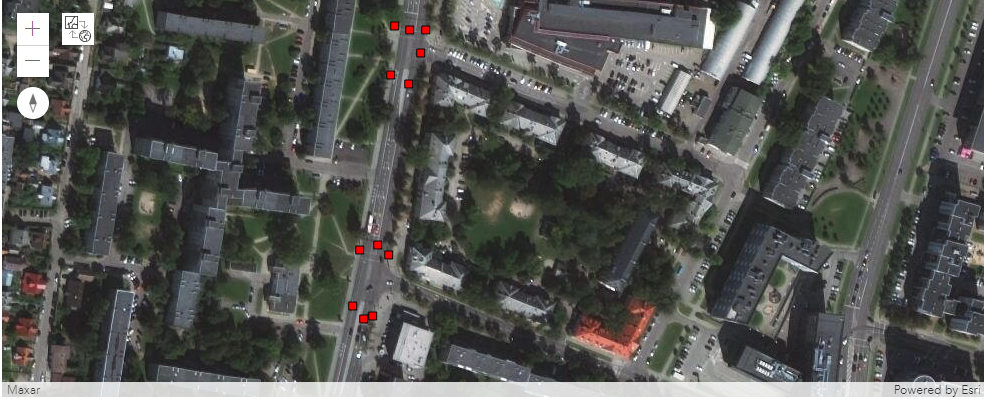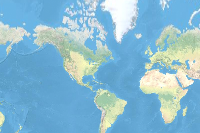- 🔬 Data Science
- 🥠 Deep Learning and Object Classification
Introduction
Generally, object detection is applied on images taken looking straight down at the ground, like in traditional satellite imagery, predictions from which can be visualized on a map and incorporated into your GIS. Other imagery, however, is more difficult to visualize and incorporate into your GIS. Such non-nadir oriented imagery includes oblique, bubble, 360-degree, street-side, and inspection imagery, among others. Through this sample, we will demonstrate the utility of an object detection model for detecting objects in oriented imagery using ArcGIS API for Python.
The arcgis.learn module supports a number of object detection models, such as SingleShotDetector, RetinaNet, FasterRCNN, YoloV3, and more. In this notebook, we will be using the YoloV3 model for detecting traffic lights in oriented imagery. The biggest advantage of YOLOv3 in arcgis.learn, is that it comes preloaded with weights pretrained on the COCO dataset. This makes it ready-to-use for the 80 common objects (car, truck, person, etc.) that are part of the COCO dataset. Using this model, we will detect traffic lights in oriented imagery.
Necessary imports
import os, json, cv2
from math import *
import numpy as np
import itertools
import pandas as pd
import zipfile
from pathlib import Pathfrom arcgis import GIS
from arcgis.geometry import Point,Geometry
from arcgis.learn import YOLOv3Download & setup data
For this notebook, we will use sample oriented imagery and oriented imagery meta data files, available on ArcGIS Online, for inferencing and plotting points.
gis = GIS("home")# Sample data can be directly downloded by clickng on the link below
oriented_imagery_data = gis.content.get("d606e6827c8746e383de96d8718be9a8")
oriented_imagery_datafilepath = oriented_imagery_data.download(save_path = os.getcwd(), file_name=oriented_imagery_data.name)with zipfile.ZipFile(filepath, 'r') as zip_ref:
zip_ref.extractall(Path(filepath).parent)After extracting the zip file, we will set the path of the items in the zip file.
data_path: Folder containing all the oriented imagery.image_meta_data: File containing meta data for all the oriented images in thedata_path.
data_path = Path(os.path.join(os.path.splitext(filepath)[0]), "street_view_data")
image_meta_data = Path(os.path.join(os.path.splitext(filepath)[0]), "oriented_imagery_meta_data.csv")image_path_list = [os.path.join(data_path, image) for image in os.listdir(data_path)]Model training
Since we are using the pretrained YOLOv3 model, we will pass the pretrained_backbone attribute as True. This will download the pre trained weights of the YOLOv3 model with COCO dataset while the YOLOv3 model is initializing. We will use these weights later to detect traffic lights.
yolo = YOLOv3(pretrained_backbone=True)Model inferencing
Once the model is loaded and ready for inferencing, we will create a function named traffic_light_finder that will take oriented imagery as input and will return the following:
Jsoncontaining traffic lights coordinates- Traffic lights annotated image
We will save all the traffic lights annotated image into a folder named traffic_light_marked and save all the annotations in a combined json file on the disk.
def traffic_light_finder(oriented_image_path):
flag = 0
coordlist = []
temp_list = {}
out = yolo.predict(
oriented_image_path, threshold=0.5, batch_size=4
) # Depending upon your GPU capability, batch_size number can be changed.
test_img = cv2.imread(oriented_image_path)
if len(out[0]) == 0:
temp_list["object"] = False
else:
for index, (value, label, confidence) in enumerate(zip(out[0], out[1], out[2])):
if label == "traffic light":
flag = 1
coordlist.append(
[int(value[0]), int(value[1]), int(value[2]), int(value[3])]
)
test_img = cv2.rectangle(
test_img,
(int(value[0]), int(value[1]), int(value[2]), int(value[3])),
(0, 0, 255),
10,
)
textvalue = label + "_" + str(confidence)
cv2.putText(
test_img,
textvalue,
(int(value[0]), int(value[1]) - 10),
cv2.FONT_HERSHEY_SIMPLEX,
1.5,
(0, 0, 255),
2,
)
if flag == 1:
temp_list["object"] = True
temp_list["coords"] = coordlist
temp_list["assetname"] = "traffic light"
return temp_list, test_img
Here we will create a folder named traffic_light_marked that will contain the images with detected traffic lights. We can use these images to check the output of the model, and later for our use case.
marked_image_saved_folder = os.path.join(os.getcwd(), "traffic_light_marked")
os.makedirs(marked_image_saved_folder, exist_ok=True)
print("Path created for saving the images with traffic light detected on them : - ", marked_image_saved_folder)Path created for saving the images with traffic light detected on them : - C:\Users\roh12004\Documents\arcgis-python-api\samples\04_gis_analysts_data_scientists\traffic_light_marked
detections = {}
for e, image in enumerate(image_path_list):
try:
val_dict, out_image = traffic_light_finder(image)
if bool(val_dict):
detections[os.path.basename(image)] = val_dict
cv2.imwrite(os.path.join(marked_image_saved_folder, os.path.basename(image)), out_image)
except Exception as e:
print(e)Here, we are also saving the coordinates of the traffic lights in a json file. We can use these coordinates to create a web map or for other use cases.
with open("traffic_light_data_sample.json", "w") as f:
json.dump(detections, f)Below are some of the images showcasing how the pretrained YOLOv3 model performs on the oriented imagery.

Extract location of traffic lights on map using Triangulation
We have successfully ran the YOLOv3 pretrained model on the oriented imagery and generated the coordinates of the detected traffic lights.
We also created an oriented image meta data CSV file (downloaded above) that contains the meta data of the oriented imagery, such as the coordinates of the image, AvgHtAG, CamHeading, CamOri, HFOV, VFOV etc. You can learn more about these data points from this document.
Using this data, we will now try to find the exact location of the traffic lights on the map.
camera_df = pd.read_csv(image_meta_data)
camera_df.head()| Unnamed: 0 | AcquisitionDate | AvgHtAG | CamHeading | CamOri | CamPitch | CamRoll | FarDist | HFOV | Image | Name | NearDist | OBJECTID | OIType | SHAPE | VFOV | |
|---|---|---|---|---|---|---|---|---|---|---|---|---|---|---|---|---|
| 0 | 0 | NaN | 2.5 | 320.86540 | 3|3346||582715.827|6063651.438|111.212|-38.134... | 88.64669 | -1.58360 | 50.0 | 360.0 | https://orientedimagerysamples.s3.amazonaws.co... | pano_000050_000371 | 1.0 | 26716 | B | {'x': 2814531.6957999994, 'y': 7304332.8588000... | 180.0 |
| 1 | 1 | NaN | 2.5 | 358.02590 | 3|3346||582717.142|6063646.62|111.26|-0.97405|... | 88.97281 | -2.20641 | 50.0 | 360.0 | https://orientedimagerysamples.s3.amazonaws.co... | pano_000050_000372 | 1.0 | 26717 | B | {'x': 2814533.810899999, 'y': 7304324.47829999... | 180.0 |
| 2 | 2 | NaN | 2.5 | 6.04420 | 3|3346||582716.637|6063641.632|111.262|7.0442|... | 88.89201 | -3.11810 | 50.0 | 360.0 | https://orientedimagerysamples.s3.amazonaws.co... | pano_000050_000373 | 1.0 | 26718 | B | {'x': 2814532.786800001, 'y': 7304315.84749999... | 180.0 |
| 3 | 3 | NaN | 2.5 | 6.31495 | 3|3346||582716.017|6063636.642|111.284|7.31495... | 88.85389 | -3.14057 | 50.0 | 360.0 | https://orientedimagerysamples.s3.amazonaws.co... | pano_000050_000374 | 1.0 | 26719 | B | {'x': 2814531.5621999986, 'y': 7304307.2359, '... | 180.0 |
| 4 | 4 | NaN | 2.5 | 6.27997 | 3|3346||582715.377|6063631.674|111.302|7.27997... | 88.77918 | -3.34327 | 50.0 | 360.0 | https://orientedimagerysamples.s3.amazonaws.co... | pano_000050_000375 | 1.0 | 26720 | B | {'x': 2814530.293200001, 'y': 7304298.6629, 's... | 180.0 |
dets = list(detections.keys())def find_intersection(
x1,
y1,
x2,
y2,
x3,
y3,
x4,
y4,
):
px = ((x1 * y2 - y1 * x2) * (x3 - x4) - (x1 - x2) * (x3 * y4 - y3 * x4)) / (
(x1 - x2) * (y3 - y4) - (y1 - y2) * (x3 - x4)
)
py = ((x1 * y2 - y1 * x2) * (y3 - y4) - (y1 - y2) * (x3 * y4 - y3 * x4)) / (
(x1 - x2) * (y3 - y4) - (y1 - y2) * (x3 - x4)
)
return [px, py]
def ccw(A, B, C):
return (C.y - A.y) * (B.x - A.x) > (B.y - A.y) * (C.x - A.x)
def intersect(A, B, C, D):
return ccw(A, C, D) != ccw(B, C, D) and ccw(A, B, C) != ccw(A, B, D)
class dotdict(dict):
"""dot.notation access to dictionary attributes"""
__getattr__ = dict.get
__setattr__ = dict.__setitem__
__delattr__ = dict.__delitem__
def process(input_list, threshold=(10, 15)):
combos = itertools.combinations(input_list, 2)
points_to_remove = [
point2
for (point1, point2) in combos
if abs(point1[0] - point2[0]) <= threshold[0]
and abs(point1[1] - point2[1]) <= threshold[1]
]
points_to_keep = [point for point in input_list if point not in points_to_remove]
return points_to_keep
(H, W, _) = cv2.imread(image_path_list[0]).shape
points = []
meta_data= []
for i in range(len(dets) - 1): # check coordinates of two consecutive images
# load data of image1
img1 = (dets[i])[:-4]
cam1 = camera_df[camera_df["Name"] == img1].to_dict("records")[0]
bboxes1 = detections[img1 + ".jpg"]["coords"]
# load data of image2
img2 = (dets[i + 1])[:-4]
cam2 = camera_df[camera_df["Name"] == img2].to_dict("records")[0]
bboxes2 = detections[img2 + ".jpg"]["coords"]
DIST = cam1["FarDist"]
for bbox1 in bboxes1: # loop over all the bbox in image1
if bbox1[3] > 50: # ignore small bboxes
x1_0 = eval(cam1["SHAPE"])["x"]
y1_0 = eval(cam1["SHAPE"])["y"]
# calculate the angle of the object in image1
direction_angle1 = cam1["CamHeading"] + cam1["HFOV"] / 2.0 * (
(bbox1[0] + bbox1[2] / 2) - W / 2.0
) / (W / 2.0)
angle_subtended_by_object1 = cam1["VFOV"] * bbox1[3] / H
# calculate the distance where the object is based on angle
x1_1 = eval(cam1["SHAPE"])["x"] + DIST * cos(
pi / 2 - radians(direction_angle1)
)
y1_1 = eval(cam1["SHAPE"])["y"] + DIST * sin(
pi / 2 - radians(direction_angle1)
)
for bbox2 in bboxes2: # loop over all the bbox in image2
if bbox2[3] > 50: # ignore small bboxes
x2_0 = eval(cam2["SHAPE"])["x"]
y2_0 = eval(cam2["SHAPE"])["y"]
# calculate the angle of the object in image2
direction_angle2 = cam2["CamHeading"] + cam2["HFOV"] / 2.0 * (
bbox2[0] + bbox2[2] / 2 - W / 2.0
) / (W / 2.0)
angle_subtended_by_object2 = cam2["VFOV"] * bbox2[3] / H
# calculate the distance where the object is based on angle
x2_1 = eval(cam2["SHAPE"])["x"] + DIST * cos(
pi / 2 - radians(direction_angle2)
)
y2_1 = eval(cam2["SHAPE"])["y"] + DIST * sin(
pi / 2 - radians(direction_angle2)
)
# find if the line intersects
val = intersect(
dotdict({"x": x1_0, "y": y1_0}),
dotdict({"x": x1_1, "y": y1_1}),
dotdict({"x": x2_0, "y": y2_0}),
dotdict({"x": x2_1, "y": y2_1}),
)
xmin, ymin, xmax, ymax = (
bbox2[0],
bbox2[1],
bbox2[0] + bbox2[2],
bbox2[1] + bbox2[3],
)
# find the point where line from image1 and image2 intersect
if val:
midpoint = find_intersection(
x1_0, y1_0, x1_1, y1_1, x2_0, y2_0, x2_1, y2_1
)
points.append(midpoint)
meta_data.append(
{
"image1": img1,
"image2": img2,
"points": midpoint,
"coords": [xmin, ymin, xmax, ymax],
"x": midpoint[0],
"y": midpoint[1],
}
)
After the above mentioned process we have got some coordinates where there will be traffic lights but as one traffic light can be detected in multiple images therefore we will further cluster the data and take only one traffic light from a cluster.
In this way we will remove the redundant traffic light near a point.
print 'Number of traffic lights extracted - {}'.format(len(points))
outpoints = process(points)
print 'Number of traffic lights extracted after clustering and removing redundant traffic light - {}'.format(len(outpoints))Number of traffic lights extracted - 302 Number of traffic lights extracted after clustering and removing redundant traffic light - 40
Results
Next, we will load a map and draw the final selected traffic light coordinates on it.
m = gis.map('Vilnius City')
m
m.center = {'x': 25.28489583988743, 'y': 54.70681816057357,
'spatialReference': {'wkid': 4326, 'latestWkid': 4326}}
m.zoom = 19
m.basemap = 'satellite'for point in outpoints:
intpoint = {'x': point[0], 'y': point[1],
'spatialReference': {'wkid': 102100,
'latestWkid': 3857}}
m.draw(arcgis.geometry.Point(intpoint), symbol={
'type': 'simple-marker',
'style': 'square',
'color': 'red',
'size': '8px',
})Exporting the output
out_meta_data = []
for e,i in enumerate(points):
if i in outpoints:
out_meta_data.append(meta_data[e])# creating a spatial dataframe and exporting as feature class
spatial_df = []
for e, i in enumerate(out_meta_data):
tempdict = {}
tempdict["X"] = i["x"]
tempdict["Y"] = i["y"]
tempdict["Z"] = 100
tempdict["ImgUrn"] = str(
i["image2"][1:]
+ "|VilniusCity_ExposurePoints|"
+ str(
camera_df[camera_df["Name"] == i["image2"]].to_dict("records")[0][
"OBJECTID"
]
)
)
tempdict["ImgGeom"] = json.dumps(
{
"xmin": i["coords"][0],
"ymin": i["coords"][1],
"xmax": i["coords"][2],
"ymax": i["coords"][3],
"pos": "BC",
}
)
tempdict["Labels"] = "traffic lights"
tempdict["SHAPE"] = Geometry(
{
"x": i["x"],
"y": i["y"],
"spatialReference": {"wkid": 3857, "latestWkid": 102100},
}
)
spatial_df.append(tempdict)
df = pd.DataFrame(data=spatial_df)
df.spatial.set_geometry("SHAPE")
# exporting the layer on ArcGIS Online org
exported_layer = df.spatial.to_featurelayer(r"exported_traffic_points", sanitize_columns=False,gis=gis)Conclusion
In this notebook, we performed object detection on oriented imagery. We used the YoloV3 model with pretrained weights for detecting traffic lights, located these on the gis map using ArcGIS API for Python, and exported the output as a feature class.
References
[1][Managing and visualizing oriented imagery](https://doc.arcgis.com/en/imagery/workflows/resources/managing-and-visualizing-oriented-imagery.htm)
[2][YOLOv3 Object Detector](https://developers.arcgis.com/python/guide/yolov3-object-detector/)
[3][Working with Oriented Imagery](https://www.esri.com/content/dam/esrisites/en-us/about/events/media/UC-2019/technical-workshops/tw-5765-872.pdf)
